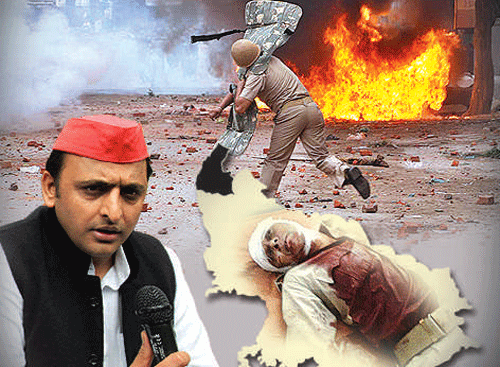
Barely a few hours journey from the national capital and famous for its beautiful and artistic wood carving works, Saharanpur almost turned out to be another Muzaffarnagar, which happens to be its neighbouring district as well.
The chemical, which was used for wood carving, was used to torch shops, houses and government buildings, when communal violence rocked the otherwise peace loving town last month during which three people were killed and over two dozen others injured.
While Muzaffarnagar communal violence last year had consumed more lives, the violence in Saharanpur scored over the former as far as loss of property was concerned. Huge showrooms of cars and electronic goods dealers, situated on the busy Ambala road were torched by the rioters and gutted completely inflicting huge losses on the owners, who were mostly Sikhs.
While the officials now firmly believe that the violence was ‘pre-planned’ and the conspiracy for the same had been hatched well in advance, they also candidly admit that the local intelligence either ignored the trouble that had been brewing for some time or simply failed in its job.
In the genesis of the violence was a small piece of land that lay near a gurudwara and a Muslim graveyard on which both Sikhs and Muslims claimed ownership. The matter had gone to the court and the latter had a few months back ruled in favour of the Sikh community but the Muslims allegedly refused to accept the verdict. Tension had been brewing since then.
And on July 27, this tension acquired a violent form when members of a particular community attacked the other while the latter were getting a wall constructed on the disputed land. Within a few hours, several posh localities of the town were engulfed by the violence. The sheer magnitude of the violence and selection of the targets make the police officials believe that the rioters had planned the whole thing in advance and were only waiting for some suitable opportunity.
The sudden violence caught the local police napping and by the time additional forces were rushed in and senior officials reached the spot, the damage had been done. What came as a shock to the officials was that the rioters, for the first time perhaps, attacked the fire station and the police personnel.
A police constable, identified as Sansarpal Malik was shot at from point blank range in front of the Qutubsher police station in the town and is now battling for his life at a hospital.
It was also surprising to see that such a large number of shops were torched within such a short time, the officials said. A senior police official said that the mob that clashed near the ‘disputed’ land in the wee hours of Sunday was heavily armed. “The people carried knives, swords and pistols,” the official said.
Burnt to ashes
Police also said that the trouble mongers had cans filled with chemical, which was used in wood carving work and was highly inflammable. “They simply threw the chemical filled cans on the shops and torched them... few cans were thrown at the people and cops,” the officials said. The rioters had also amassed weapons in advance.
It later turned out that an ex-corporator Moharram Ali alias Pappu, who has been arrested, had fuelled the Saharanpur communal violence after he failed to get the land dispute matter resolved the way he desired. Ali had allegedly demanded money to settle the matter and had been paid some advance also. The officials said that Ali and his goons had prepared their strategy at least two days back to orchestrate violence.
“Ali had asked his goons to bring in the crowds to the disputed land from different parts of the city on the day of violence,” they said.
It later turned out that Ali also had strong political connections. He had started his political career with Congress but had later joined the BSP when Mayawati formed her government. He later shifted allegiance once again in April this year and joined the Samajwadi Party (SP) with his ‘political master’ and former minister Sanjay Garg. He is said to be a close confidante of Garg and was also a key member of Garg’s electoral team.
Earlier Ali was said to be close to Congress leader Imran Masood. It was Masood, who had tried to incite communal passion during the recent Lok Sabha polls when he said that he would “cut Narendra Modi into pieces if he (Modi) tried to crush the Muslims the way he (Modi) had done in Gujarat.”
The government, apparently on the back foot following outbreak of recurring communal violence, has decided to act tough this time and invoked the stringent National Security Act (NSA) on the rioters.
Though the town was limping back to its normal ways gradually, politicians and social activists both admit that the violence had driven a wedge between the two communities and wounds are too deep to be healed in the near future.
With a by-poll being due in the next few months in Saharanpur and the next Assembly elections due in two and half year time, further communal flare ups in the communally sensitive town could not be ruled out, they said.